Tag Archives: c-sharp
C# || How To Find The Minimum Fuel Cost To Report To The Capital Using C#

The following is a module with functions which demonstrates how to find the minimum fuel cost to report to the capital using C#.
1. Minimum Fuel Cost – Problem Statement
There is a tree (i.e., a connected, undirected graph with no cycles) structure country network consisting of n cities numbered from 0 to n – 1 and exactly n – 1 roads. The capital city is city 0. You are given a 2D integer array roads where roads[i] = [ai, bi] denotes that there exists a bidirectional road connecting cities ai and bi.
There is a meeting for the representatives of each city. The meeting is in the capital city.
There is a car in each city. You are given an integer seats that indicates the number of seats in each car.
A representative can use the car in their city to travel or change the car and ride with another representative. The cost of traveling between two cities is one liter of fuel.
Return the minimum number of liters of fuel to reach the capital city.
Example 1:
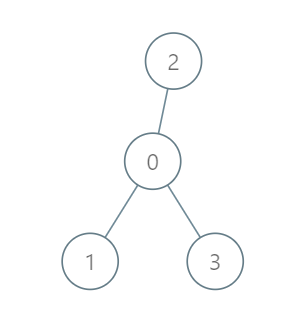
Input: roads = [[0,1],[0,2],[0,3]], seats = 5
Output: 3
Explanation:
- Representative1 goes directly to the capital with 1 liter of fuel.
- Representative2 goes directly to the capital with 1 liter of fuel.
- Representative3 goes directly to the capital with 1 liter of fuel.
It costs 3 liters of fuel at minimum.
It can be proven that 3 is the minimum number of liters of fuel needed.
Example 2:

Input: roads = [[3,1],[3,2],[1,0],[0,4],[0,5],[4,6]], seats = 2
Output: 7
Explanation:
- Representative2 goes directly to city 3 with 1 liter of fuel.
- Representative2 and representative3 go together to city 1 with 1 liter of fuel.
- Representative2 and representative3 go together to the capital with 1 liter of fuel.
- Representative1 goes directly to the capital with 1 liter of fuel.
- Representative5 goes directly to the capital with 1 liter of fuel.
- Representative6 goes directly to city 4 with 1 liter of fuel.
- Representative4 and representative6 go together to the capital with 1 liter of fuel.
It costs 7 liters of fuel at minimum.
It can be proven that 7 is the minimum number of liters of fuel needed.
Example 3:

Input: roads = [], seats = 1
Output: 0
Explanation: No representatives need to travel to the capital city.
2. Minimum Fuel Cost – Solution
The following is a solution which demonstrates how to find the minimum fuel cost to report to the capital.
|
1 2 3 4 5 6 7 8 9 10 11 12 13 14 15 16 17 18 19 20 21 22 23 24 25 26 27 28 29 30 31 32 33 34 35 36 37 38 39 40 41 42 43 44 45 46 47 48 49 50 51 52 53 54 55 56 57 58 |
// ============================================================================ // Author: Kenneth Perkins // Date: May 24, 2023 // Taken From: http://programmingnotes.org/ // File: Solution.cs // Description: Demonstrates how to find minimum fuel cost to the capital // ============================================================================ public class Solution { public long MinimumFuelCost(int[][] roads, int seats) { int n = roads.Length + 1; var adj = new Dictionary<int, List<int>>(); int[] degree = new int[n]; foreach (int[] road in roads) { if (!adj.ContainsKey(road[0])) { adj[road[0]] = new List<int>(); } adj[road[0]].Add(road[1]); if (!adj.ContainsKey(road[1])) { adj[road[1]] = new List<int>(); } adj[road[1]].Add(road[0]); ++degree[road[0]]; ++degree[road[1]]; } return BFS(n, adj, degree, seats); } public long BFS(int n, Dictionary<int, List<int>> adj, int[] degree, int seats) { var q = new Queue<int>(); for (int i = 1; i < n; i++) { if (degree[i] == 1) { q.Enqueue(i); } } int[] representatives = new int[n]; Array.Fill(representatives, 1); long fuel = 0; while (q.Count > 0) { int node = q.Dequeue(); fuel += (long)Math.Ceiling((double) representatives[node] / seats); foreach (int neighbor in adj[node]) { --degree[neighbor]; representatives[neighbor] += representatives[node]; if (degree[neighbor] == 1 && neighbor != 0) { q.Enqueue(neighbor); } } } return fuel; } }// http://programmingnotes.org/ |
QUICK NOTES:
The highlighted lines are sections of interest to look out for.
The code is heavily commented, so no further insight is necessary. If you have any questions, feel free to leave a comment below.
Once compiled, you should get this as your output for the example cases:
3
7
0
C# || How To Find The Minimum Time To Collect All Apples In A Tree Using C#

The following is a module with functions which demonstrates how to find the minimum time to collect all apples in a tree using C#.
1. Min Time – Problem Statement
Given an undirected tree consisting of n vertices numbered from 0 to n-1, which has some apples in their vertices. You spend 1 second to walk over one edge of the tree. Return the minimum time in seconds you have to spend to collect all apples in the tree, starting at vertex 0 and coming back to this vertex.
The edges of the undirected tree are given in the array edges, where edges[i] = [ai, bi] means that exists an edge connecting the vertices ai and bi. Additionally, there is a boolean array hasApple, where hasApple[i] = true means that vertex i has an apple; otherwise, it does not have any apple.
Example 1:
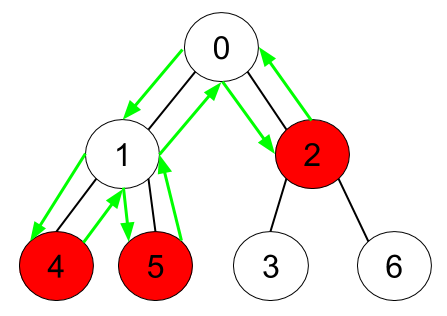
Input: n = 7, edges = [[0,1],[0,2],[1,4],[1,5],[2,3],[2,6]], hasApple = [false,false,true,false,true,true,false]
Output: 8
Explanation: The figure above represents the given tree where red vertices have an apple. One optimal path to collect all apples is shown by the green arrows.
Example 2:

Input: n = 7, edges = [[0,1],[0,2],[1,4],[1,5],[2,3],[2,6]], hasApple = [false,false,true,false,false,true,false]
Output: 6
Explanation: The figure above represents the given tree where red vertices have an apple. One optimal path to collect all apples is shown by the green arrows.
Example 3:
Input: n = 7, edges = [[0,1],[0,2],[1,4],[1,5],[2,3],[2,6]], hasApple = [false,false,false,false,false,false,false]
Output: 0
2. Min Time – Solution
The following is a solution which demonstrates how to find the cheapest flights within K stops.
|
1 2 3 4 5 6 7 8 9 10 11 12 13 14 15 16 17 18 19 20 21 22 23 24 25 26 27 28 29 30 31 32 33 34 35 36 37 38 39 40 41 42 43 44 45 46 |
// ============================================================================ // Author: Kenneth Perkins // Date: May 23, 2023 // Taken From: http://programmingnotes.org/ // File: Solution.cs // Description: Demonstrates how to find minimum time to collect apples // ============================================================================ public class Solution { public int MinTime(int n, int[][] edges, IList<bool> hasApple) { var adj = new Dictionary<int, List<int>>(); foreach (int[] edge in edges) { int a = edge[0]; int b = edge[1]; if (!adj.ContainsKey(a)) { adj[a] = new List<int>(); } if (!adj.ContainsKey(b)) { adj[b] = new List<int>(); } adj[a].Add(b); adj[b].Add(a); } return DFS(0, -1, adj, hasApple); } public int DFS(int node, int parent, Dictionary<int, List<int>> adj, IList<bool> hasApple) { if (!adj.ContainsKey(node)) { return 0; } int totalTime = 0; foreach (int child in adj[node]) { if (child == parent) { continue; } int childTime = DFS(child, node, adj, hasApple); // childTime > 0 indicates subtree of child has apples. Since the root node of the // subtree does not contribute to the time, even if it has an apple, we have to check it // independently. if (childTime > 0 || hasApple[child]) { totalTime += childTime + 2; } } return totalTime; } }// http://programmingnotes.org/ |
QUICK NOTES:
The highlighted lines are sections of interest to look out for.
The code is heavily commented, so no further insight is necessary. If you have any questions, feel free to leave a comment below.
Once compiled, you should get this as your output for the example cases:
8
6
0
C# || How To Sort An Array O(nlog(n)) Using C#

The following is a module with functions which demonstrates how to sort an array O(nlog(n)) complexity using C#.
1. Sort Array – Problem Statement
Given an array of integers nums, sort the array in ascending order and return it.
You must solve the problem without using any built-in functions in O(nlog(n)) time complexity and with the smallest space complexity possible.
Example 1:
Input: nums = [5,2,3,1]
Output: [1,2,3,5]
Explanation: After sorting the array, the positions of some numbers are not changed (for example, 2 and 3), while the positions of other numbers are changed (for example, 1 and 5).
Example 2:
Input: nums = [5,1,1,2,0,0]
Output: [0,0,1,1,2,5]
Explanation: Note that the values of nums are not necessairly unique.
2. Sort Array – Solution
The following is a solution which demonstrates how to sort an array O(nlog(n)) complexity using C#.
|
1 2 3 4 5 6 7 8 9 10 11 12 13 14 15 16 17 18 19 20 21 22 23 24 25 26 27 28 29 30 31 32 33 34 35 36 37 38 39 40 41 42 43 44 45 46 47 48 49 50 51 52 53 54 55 56 57 58 59 60 61 62 63 64 65 66 67 68 69 70 71 72 73 74 75 76 77 78 79 |
// ============================================================================ // Author: Kenneth Perkins // Date: May 1, 2023 // Taken From: http://programmingnotes.org/ // File: Solution.cs // Description: Demonstrates how to sort an array O(nlog(n)) // ============================================================================ public class Solution { public int[] SortArray(int[] nums) { RadixSort(nums); return nums; } // Radix sort function. private void RadixSort(int[] arr) { // Find the absolute maximum element to find max number of digits. int maxElement = arr[0]; foreach (int val in arr) { maxElement = Math.Max(Math.Abs(val), maxElement); } int maxDigits = 0; while (maxElement > 0) { maxDigits += 1; maxElement /= 10; } // Radix sort, least significant digit place to most significant. int placeValue = 1; for (int digit = 0; digit < maxDigits; ++digit) { BucketSort(arr, placeValue); placeValue *= 10; } // Seperate out negatives and reverse them. List<int> negatives = new List<int>(); List<int> positives = new List<int>(); foreach (int val in arr) { if (val < 0) { negatives.Add(val); } else { positives.Add(val); } } negatives.Reverse(); // Final 'answer' will be 'negative' elements, then 'positive' elements. int index = 0; foreach (int val in negatives) { arr[index++] = val; } foreach (int val in positives) { arr[index++] = val; } } // Bucket sort function for each place value digit. private void BucketSort(int[] arr, int placeValue) { int bucketSize = 10; List<List<int>> buckets = new List<List<int>>(); for (int digit = 0; digit < bucketSize; ++digit) { buckets.Add(new List<int>()); } // Store the respective number based on its digit. foreach (int val in arr) { int digit = Math.Abs(val) / placeValue; digit = digit % bucketSize; buckets[digit].Add(val); } // Overwrite 'arr' in sorted order of current place digits. int index = 0; for (int digit = 0; digit < bucketSize; ++digit) { foreach (int val in buckets[digit]) { arr[index++] = val; } } } }// http://programmingnotes.org/ |
QUICK NOTES:
The highlighted lines are sections of interest to look out for.
The code is heavily commented, so no further insight is necessary. If you have any questions, feel free to leave a comment below.
Once compiled, you should get this as your output for the example cases:
[1,2,3,5]
[0,0,1,1,2,5]
C# || How To Find The Cheapest Flights Within K Stops Using C#

The following is a module with functions which demonstrates how to find the cheapest flights within K stops using C#.
1. Find Cheapest Price – Problem Statement
There are n cities connected by some number of flights. You are given an array flights where flights[i] = [fromi, toi, pricei] indicates that there is a flight from city fromi to city toi with cost pricei.
You are also given three integers src, dst, and k, return the cheapest price from src to dst with at most k stops. If there is no such route, return -1.
Example 1:
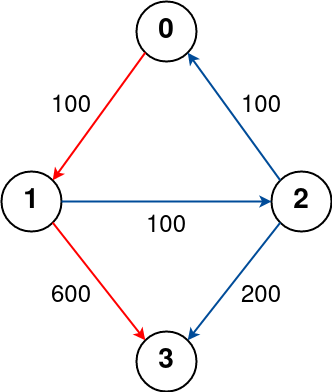
Input: n = 4, flights = [[0,1,100],[1,2,100],[2,0,100],[1,3,600],[2,3,200]], src = 0, dst = 3, k = 1
Output: 700
Explanation:
The graph is shown above.
The optimal path with at most 1 stop from city 0 to 3 is marked in red and has cost 100 + 600 = 700.
Note that the path through cities [0,1,2,3] is cheaper but is invalid because it uses 2 stops.
Example 2:
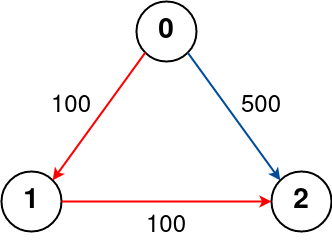
Input: n = 3, flights = [[0,1,100],[1,2,100],[0,2,500]], src = 0, dst = 2, k = 1
Output: 200
Explanation:
The graph is shown above.
The optimal path with at most 1 stop from city 0 to 2 is marked in red and has cost 100 + 100 = 200.
Example 3:
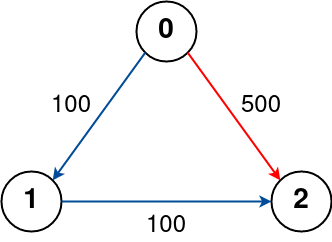
Input: n = 3, flights = [[0,1,100],[1,2,100],[0,2,500]], src = 0, dst = 2, k = 0
Output: 500
Explanation:
The graph is shown above.
The optimal path with no stops from city 0 to 2 is marked in red and has cost 500.
2. Find Cheapest Price – Solution
The following is a solution which demonstrates how to find the cheapest flights within K stops.
|
1 2 3 4 5 6 7 8 9 10 11 12 13 14 15 16 17 18 19 20 21 22 23 24 25 26 27 28 29 30 31 32 33 34 35 36 37 38 39 40 41 42 43 44 45 46 47 48 49 50 |
// ============================================================================ // Author: Kenneth Perkins // Date: Apr 1, 2023 // Taken From: http://programmingnotes.org/ // File: Solution.cs // Description: Demonstrates how to find cheapest flights in k stops // ============================================================================ public class Solution { public int FindCheapestPrice(int n, int[][] flights, int src, int dst, int k) { var adj = new Dictionary<int, List<int[]>>(); foreach (int[] i in flights) { if (!adj.ContainsKey(i[0])) { adj[i[0]] = new List<int[]>(); } adj[i[0]].Add(new int[] { i[1], i[2] }); } int[] stops = new int[n]; Array.Fill(stops, int.MaxValue); var pq = new PriorityQueue<int[], int[]>(Comparer<int[]>.Create((a, b) => a[0] - b[0])); // {dist_from_src_node, node, number_of_stops_from_src_node} var distance = new int[] { 0, src, 0 }; pq.Enqueue(distance, distance); while (pq.Count > 0) { int[] temp = pq.Dequeue(); int dist = temp[0]; int node = temp[1]; int steps = temp[2]; // We have already encountered a path with a lower cost and fewer stops, // or the number of stops exceeds the limit. if (steps > stops[node] || steps > k + 1) { continue; } stops[node] = steps; if (node == dst) { return dist; } if (!adj.ContainsKey(node)) { continue; } foreach (int[] a in adj[node]) { var newDistance = new int[] { dist + a[1], a[0], steps + 1 }; pq.Enqueue(newDistance, newDistance); } } return -1; } }// http://programmingnotes.org/ |
QUICK NOTES:
The highlighted lines are sections of interest to look out for.
The code is heavily commented, so no further insight is necessary. If you have any questions, feel free to leave a comment below.
Once compiled, you should get this as your output for the example cases:
700
200
500
C# || Daily Temperatures – How To Find The Number Of Days Until Warmer Temperature Using C#

The following is a module with functions which demonstrates how to find the number of days until warmer temperature using C#.
1. Daily Temperatures – Problem Statement
Given an array of integers temperatures represents the daily temperatures, return an array answer such that answer[i] is the number of days you have to wait after the ith day to get a warmer temperature. If there is no future day for which this is possible, keep answer[i] == 0 instead.
Example 1:
Input: temperatures = [73,74,75,71,69,72,76,73]
Output: [1,1,4,2,1,1,0,0]
Example 2:
Input: temperatures = [30,40,50,60]
Output: [1,1,1,0]
Example 3:
Input: temperatures = [30,60,90]
Output: [1,1,0]
2. Daily Temperatures – Solution
The following is a solution which demonstrates how to find the number of days until warmer temperature.
This solution uses the monotonic stack approach.
|
1 2 3 4 5 6 7 8 9 10 11 12 13 14 15 16 17 18 19 20 21 22 23 24 25 26 27 28 29 |
// ============================================================================ // Author: Kenneth Perkins // Date: Mar 1, 2023 // Taken From: http://programmingnotes.org/ // File: Solution.cs // Description: Demonstrates how to find number of days until warmer temperature // ============================================================================ public class Solution { public int[] DailyTemperatures(int[] temperatures) { // Stack used to save the array index of each item var stack = new Stack<int>(); var result = new int[temperatures.Length]; // Go through items in the array for (int currentIndex = 0; currentIndex < temperatures.Length; ++currentIndex) { // Compare the item at the top of the stack to the current array item. // If the item at the top of stack is less than current array item, // save the distance between the array indexes in the result array. while (stack.Count > 0 && temperatures[stack.Peek()] < temperatures[currentIndex]) { // Get the distance between the two array indexes var previousIndex = stack.Pop(); result[previousIndex] = currentIndex - previousIndex; } // Save the array index for this item to the stack stack.Push(currentIndex); } return result; } }// http://programmingnotes.org/ |
QUICK NOTES:
The highlighted lines are sections of interest to look out for.
The code is heavily commented, so no further insight is necessary. If you have any questions, feel free to leave a comment below.
Once compiled, you should get this as your output for the example cases:
[1,1,4,2,1,1,0,0]
[1,1,1,0]
[1,1,0]
C# || How To Find Maximum Difference Between Node and Ancestor In Binary Tree Using C#

The following is a module with functions which demonstrates how to find the maximum difference between node and ancestor in binary tree using C#.
1. Max Ancestor Diff – Problem Statement
Given the root of a binary tree, find the maximum value v for which there exist different nodes a and b where v = |a.val – b.val| and a is an ancestor of b.
A node a is an ancestor of b if either: any child of a is equal to b or any child of a is an ancestor of b.
Example 1:
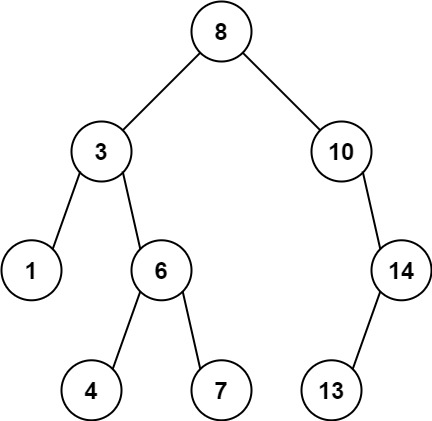
Input: root = [8,3,10,1,6,null,14,null,null,4,7,13]
Output: 7
Explanation: We have various ancestor-node differences, some of which are given below :
|8 - 3| = 5
|3 - 7| = 4
|8 - 1| = 7
|10 - 13| = 3
Among all possible differences, the maximum value of 7 is obtained by |8 - 1| = 7.
Example 2:
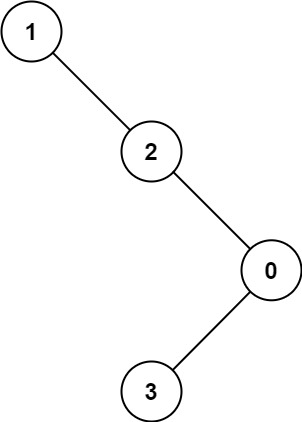
Input: root = [1,null,2,null,0,3]
Output: 3
2. Max Ancestor Diff – Solution
The following is a solution which demonstrates how to find the maximum difference between node and ancestor in binary tree.
|
1 2 3 4 5 6 7 8 9 10 11 12 13 14 15 16 17 18 19 20 21 22 23 24 25 26 27 28 29 30 31 32 33 34 35 36 37 38 39 40 41 42 |
// ============================================================================ // Author: Kenneth Perkins // Date: Feb 14, 2023 // Taken From: http://programmingnotes.org/ // File: Solution.cs // Description: Demonstrates how to find maximum difference node and ancestor // ============================================================================ /** * Definition for a binary tree node. * public class TreeNode { * public int val; * public TreeNode left; * public TreeNode right; * public TreeNode(int val=0, TreeNode left=null, TreeNode right=null) { * this.val = val; * this.left = left; * this.right = right; * } * } */ public class Solution { public int MaxAncestorDiff(TreeNode root) { if (root == null) { return 0; } return Traverse(root, root.val, root.val); } public int Traverse(TreeNode node, int curMax, int curMin) { // if encounter leaves, return the max-min along the path if (node == null) { return curMax - curMin; } // else, update max and min // and return the max of left and right subtrees curMax = Math.Max(curMax, node.val); curMin = Math.Min(curMin, node.val); int left = Traverse(node.left, curMax, curMin); int right = Traverse(node.right, curMax, curMin); return Math.Max(left, right); } }// http://programmingnotes.org/ |
QUICK NOTES:
The highlighted lines are sections of interest to look out for.
The code is heavily commented, so no further insight is necessary. If you have any questions, feel free to leave a comment below.
Once compiled, you should get this as your output for the example cases:
7
3
C# || How To Remove Stones To Minimize The Total Using C#

The following is a module with functions which demonstrates how to remove stones to minimize the total using C#.
1. Min Stone Sum – Problem Statement
You are given a 0-indexed integer array piles, where piles[i] represents the number of stones in the ith pile, and an integer k. You should apply the following operation exactly k times:
- Choose any piles[i] and remove floor(piles[i] / 2) stones from it.
Notice that you can apply the operation on the same pile more than once.
Return the minimum possible total number of stones remaining after applying the k operations.
floor(x) is the greatest integer that is smaller than or equal to x (i.e., rounds x down).
Example 1:
Input: piles = [5,4,9], k = 2
Output: 12
Explanation: Steps of a possible scenario are:
- Apply the operation on pile 2. The resulting piles are [5,4,5].
- Apply the operation on pile 0. The resulting piles are [3,4,5].
The total number of stones in [3,4,5] is 12.
Example 2:
Input: piles = [4,3,6,7], k = 3
Output: 12
Explanation: Steps of a possible scenario are:
- Apply the operation on pile 2. The resulting piles are [4,3,3,7].
- Apply the operation on pile 3. The resulting piles are [4,3,3,4].
- Apply the operation on pile 0. The resulting piles are [2,3,3,4].
The total number of stones in [2,3,3,4] is 12.
2. Min Stone Sum – Solution
The following is a solution which demonstrates how to remove stones to minimize the total.
|
1 2 3 4 5 6 7 8 9 10 11 12 13 14 15 16 17 18 19 20 21 22 23 24 25 26 27 28 |
// ============================================================================ // Author: Kenneth Perkins // Date: Feb 1, 2023 // Taken From: http://programmingnotes.org/ // File: Solution.cs // Description: Demonstrates how to remove stones to minimize the total // ============================================================================ public class Solution { public int MinStoneSum(int[] piles, int k) { var heap = new PriorityQueue<int, int>(Comparer<int>.Create((a, b) => b - a)); int totalSum = 0; foreach (int num in piles) { heap.Enqueue(num, num); totalSum += num; } for (int index = 0; index < k; ++index) { int currentValue = heap.Dequeue(); int removeFromTotal = currentValue / 2; int newValue = currentValue - removeFromTotal; heap.Enqueue(newValue, newValue); totalSum -= removeFromTotal; } return totalSum; } }// http://programmingnotes.org/ |
QUICK NOTES:
The highlighted lines are sections of interest to look out for.
The code is heavily commented, so no further insight is necessary. If you have any questions, feel free to leave a comment below.
Once compiled, you should get this as your output for the example cases:
12
12
C# || Single-Threaded CPU – How To Find The Order CPU Will Process Tasks Using C#

The following is a module with functions which demonstrates how to find the order CPU will process tasks using C#.
1. Get Order – Problem Statement
You are given n tasks labeled from 0 to n – 1 represented by a 2D integer array tasks, where tasks[i] = [enqueueTimei, processingTimei] means that the ith task will be available to process at enqueueTimei and will take processingTimei to finish processing.
You have a single-threaded CPU that can process at most one task at a time and will act in the following way:
- If the CPU is idle and there are no available tasks to process, the CPU remains idle.
- If the CPU is idle and there are available tasks, the CPU will choose the one with the shortest processing time. If multiple tasks have the same shortest processing time, it will choose the task with the smallest index.
- Once a task is started, the CPU will process the entire task without stopping.
- The CPU can finish a task then start a new one instantly.
Return the order in which the CPU will process the tasks.
Example 1:
Input: tasks = [[1,2],[2,4],[3,2],[4,1]]
Output: [0,2,3,1]
Explanation: The events go as follows:
- At time = 1, task 0 is available to process. Available tasks = {0}.
- Also at time = 1, the idle CPU starts processing task 0. Available tasks = {}.
- At time = 2, task 1 is available to process. Available tasks = {1}.
- At time = 3, task 2 is available to process. Available tasks = {1, 2}.
- Also at time = 3, the CPU finishes task 0 and starts processing task 2 as it is the shortest. Available tasks = {1}.
- At time = 4, task 3 is available to process. Available tasks = {1, 3}.
- At time = 5, the CPU finishes task 2 and starts processing task 3 as it is the shortest. Available tasks = {1}.
- At time = 6, the CPU finishes task 3 and starts processing task 1. Available tasks = {}.
- At time = 10, the CPU finishes task 1 and becomes idle.
Example 2:
Input: tasks = [[7,10],[7,12],[7,5],[7,4],[7,2]]
Output: [4,3,2,0,1]
Explanation: The events go as follows:
- At time = 7, all the tasks become available. Available tasks = {0,1,2,3,4}.
- Also at time = 7, the idle CPU starts processing task 4. Available tasks = {0,1,2,3}.
- At time = 9, the CPU finishes task 4 and starts processing task 3. Available tasks = {0,1,2}.
- At time = 13, the CPU finishes task 3 and starts processing task 2. Available tasks = {0,1}.
- At time = 18, the CPU finishes task 2 and starts processing task 0. Available tasks = {1}.
- At time = 28, the CPU finishes task 0 and starts processing task 1. Available tasks = {}.
- At time = 40, the CPU finishes task 1 and becomes idle.
2. Get Order – Solution
The following is a solution which demonstrates how to find the order CPU will process tasks.
|
1 2 3 4 5 6 7 8 9 10 11 12 13 14 15 16 17 18 19 20 21 22 23 24 25 26 27 28 29 30 31 32 33 34 35 36 37 38 39 40 41 42 43 44 45 46 47 48 49 50 51 52 53 54 55 56 57 58 59 60 |
// ============================================================================ // Author: Kenneth Perkins // Date: Jan 27, 2023 // Taken From: http://programmingnotes.org/ // File: Solution.cs // Description: Demonstrates how to find the order CPU will process tasks // ============================================================================ public class Solution { private const int ENQUEUE_TIME = 0; private const int PROCESSING_TIME = 1; private const int INDEX = 2; public int[] GetOrder(int[][] tasks) { // Sort based on min task processing time or min task index. // Store enqueue time, processing time, task index. var nextTask = new PriorityQueue<int[], int[]>(Comparer<int[]>.Create((a, b) => (a[PROCESSING_TIME] != b[PROCESSING_TIME] ? (a[PROCESSING_TIME] - b[PROCESSING_TIME]) : (a[INDEX] - b[INDEX])))); // Store task enqueue time, processing time, index. int[][] sortedTasks = new int[tasks.Length][]; for (int index = 0; index < sortedTasks.Length; ++index) { sortedTasks[index] = new int[3]; } for (int index = 0; index < tasks.Length; ++index) { sortedTasks[index][ENQUEUE_TIME] = tasks[index][ENQUEUE_TIME]; sortedTasks[index][PROCESSING_TIME] = tasks[index][PROCESSING_TIME]; sortedTasks[index][INDEX] = index; } Array.Sort(sortedTasks, (a, b) => a[ENQUEUE_TIME] - b[ENQUEUE_TIME]); int[] tasksProcessingOrder = new int[tasks.Length]; long currentTime = 0; int taskIndex = 0; int ansIndex = 0; // Stop when no tasks are left in array and heap. while (taskIndex < tasks.Length || nextTask.Count > 0) { if (nextTask.Count == 0 && currentTime < sortedTasks[taskIndex][ENQUEUE_TIME]) { // When the heap is empty, try updating currentTime to next task's enqueue time. currentTime = sortedTasks[taskIndex][ENQUEUE_TIME]; } // Push all the tasks whose enqueueTime <= currtTime into the heap. while (taskIndex < tasks.Length && currentTime >= sortedTasks[taskIndex][ENQUEUE_TIME]) { nextTask.Enqueue(sortedTasks[taskIndex], sortedTasks[taskIndex]); ++taskIndex; } int[] task = nextTask.Dequeue(); int processTime = task[PROCESSING_TIME]; int index = task[INDEX]; // Complete this task and increment currentTime. currentTime += processTime; tasksProcessingOrder[ansIndex++] = index; } return tasksProcessingOrder; } }// http://programmingnotes.org/ |
QUICK NOTES:
The highlighted lines are sections of interest to look out for.
The code is heavily commented, so no further insight is necessary. If you have any questions, feel free to leave a comment below.
Once compiled, you should get this as your output for the example cases:
[0,2,3,1]
[4,3,2,0,1]
C# || How To Determine If String Halves Are Alike Using C#

The following is a module with functions which demonstrates how to determine if string halves are alike using C#.
1. Halves Are A like – Problem Statement
You are given a string s of even length. Split this string into two halves of equal lengths, and let a be the first half and b be the second half.
Two strings are alike if they have the same number of vowels (‘a’, ‘e’, ‘i’, ‘o’, ‘u’, ‘A’, ‘E’, ‘I’, ‘O’, ‘U’). Notice that s contains uppercase and lowercase letters.
Return true if a and b are alike. Otherwise, return false.
Example 1:
Input: s = "book"
Output: true
Explanation: a = "bo" and b = "ok". a has 1 vowel and b has 1 vowel. Therefore, they are alike.
Example 2:
Input: s = "textbook"
Output: false
Explanation: a = "text" and b = "book". a has 1 vowel whereas b has 2. Therefore, they are not alike.
Notice that the vowel o is counted twice.
2. Halves Are A like – Solution
The following is a solution which demonstrates how to determine if string halves are alike.
|
1 2 3 4 5 6 7 8 9 10 11 12 13 14 15 16 17 18 19 20 21 22 23 24 25 26 27 28 29 30 31 32 |
// ============================================================================ // Author: Kenneth Perkins // Date: Jan 2, 2023 // Taken From: http://programmingnotes.org/ // File: Solution.cs // Description: Demonstrates how to determine if string halves are alike // ============================================================================ public class Solution { public bool HalvesAreAlike(string s) { // Get first half count int firstHalfVowel = 0; for (int index = 0; index < s.Length / 2; ++index) { if (IsVowel(s[index])) { ++firstHalfVowel; } } // Get second half count int secondHalfVowel = 0; for (int index = s.Length / 2 ; index < s.Length && secondHalfVowel <= firstHalfVowel; ++index) { if (IsVowel(s[index])) { ++secondHalfVowel; } } return firstHalfVowel == secondHalfVowel; } private static bool IsVowel(char ch) { ch = char.ToLower(ch); return ch == 'a' || ch == 'e' || ch == 'i' || ch == 'o' || ch == 'u'; } }// http://programmingnotes.org/ |
QUICK NOTES:
The highlighted lines are sections of interest to look out for.
The code is heavily commented, so no further insight is necessary. If you have any questions, feel free to leave a comment below.
Once compiled, you should get this as your output for the example cases:
true
false
C# || How To Find The Maximum Profit In Job Scheduling Using C#

The following is a module with functions which demonstrates how to find the maximum profit in job scheduling using C#.
1. Job Scheduling – Problem Statement
We have n jobs, where every job is scheduled to be done from startTime[i] to endTime[i], obtaining a profit of profit[i].
You’re given the startTime, endTime and profit arrays, return the maximum profit you can take such that there are no two jobs in the subset with overlapping time range.
If you choose a job that ends at time X you will be able to start another job that starts at time X.
Example 1:
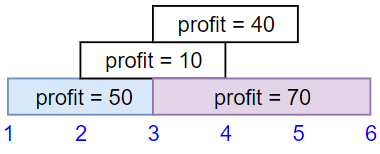
Input: startTime = [1,2,3,3], endTime = [3,4,5,6], profit = [50,10,40,70]
Output: 120
Explanation: The subset chosen is the first and fourth job.
Time range [1-3]+[3-6] , we get profit of 120 = 50 + 70.
Example 2:

Input: startTime = [1,2,3,4,6], endTime = [3,5,10,6,9], profit = [20,20,100,70,60]
Output: 150
Explanation: The subset chosen is the first, fourth and fifth job.
Profit obtained 150 = 20 + 70 + 60.
Example 3:

Input: startTime = [1,1,1], endTime = [2,3,4], profit = [5,6,4]
Output: 6
2. Job Scheduling – Solution
The following is a solution which demonstrates how to find the maximum profit in job scheduling.
|
1 2 3 4 5 6 7 8 9 10 11 12 13 14 15 16 17 18 19 20 21 22 23 24 25 26 27 28 29 30 31 32 33 34 35 36 37 38 39 40 41 42 43 44 45 46 47 48 49 50 51 52 53 54 55 56 57 58 59 60 61 62 63 64 65 66 67 68 69 70 71 |
// ============================================================================ // Author: Kenneth Perkins // Date: Jan 1, 2023 // Taken From: http://programmingnotes.org/ // File: Solution.cs // Description: Demonstrates how to find maximum profit in job scheduling // ============================================================================ public class Solution { public int JobScheduling(int[] startTime, int[] endTime, int[] profit) { if (startTime == null || startTime.Length == 0) { return 0; } var jobs = new List<Job>(); for (int index = 0; index < startTime.Length; ++index) { jobs.Add(new Job(startTime[index], endTime[index], profit[index])); } jobs.Sort((a, b) => a.Start - b.Start); return DFS(jobs, 0, new Dictionary<int, int>()); } private int DFS(List<Job> jobs, int currentJobIndex, Dictionary<int, int> maxProfits) { if (currentJobIndex >= jobs.Count) { return 0; } if (maxProfits.ContainsKey(currentJobIndex)) { return maxProfits[currentJobIndex]; } int next = BinarySearch(jobs, currentJobIndex); int inc = jobs[currentJobIndex].Profit + (next == -1 ? 0 : DFS(jobs, next, maxProfits)); int exc = DFS(jobs, currentJobIndex + 1, maxProfits); int maxProfit = Math.Max(inc, exc); maxProfits[currentJobIndex] = maxProfit; return maxProfit; } private int BinarySearch(List<Job> jobs, int currentJobIndex) { int lo = currentJobIndex; int high = jobs.Count - 1; int result = -1; while (lo <= high) { int mid = lo + (high - lo) / 2; if (jobs[currentJobIndex].End <= jobs[mid].Start) { result = mid; high = mid - 1; } else { lo = mid + 1; } } return result; } class Job { public int Start { get; set; } public int End { get; set; } public int Profit { get; set; } public Job(int startTime, int endTime, int profit) { Start = startTime; End = endTime; Profit = profit; } } }// http://programmingnotes.org/ |
QUICK NOTES:
The highlighted lines are sections of interest to look out for.
The code is heavily commented, so no further insight is necessary. If you have any questions, feel free to leave a comment below.
Once compiled, you should get this as your output for the example cases:
120
150
6
C# || Contains Duplicate II – How To Determine Two Distinct Indices In Array Equal To Target Value Using C#

The following is a module with functions which demonstrates how to determine two distinct indices in array equal to target value using C#.
1. Contains Nearby Duplicate – Problem Statement
Given an integer array nums and an integer k, return true if there are two distinct indices i and j in the array such that nums[i] == nums[j] and abs(i – j) <= k.
Example 1:
Input: nums = [1,2,3,1], k = 3
Output: true
Example 2:
Input: nums = [1,0,1,1], k = 1
Output: true
Example 3:
Input: nums = [1,2,3,1,2,3], k = 2
Output: false
2. Contains Nearby Duplicate – Solution
The following are two solutions which demonstrates how to determine two distinct indices in array equal to target value.
|
1 2 3 4 5 6 7 8 9 10 11 12 13 14 15 16 17 18 19 20 21 |
// ============================================================================ // Author: Kenneth Perkins // Date: Dec 25, 2022 // Taken From: http://programmingnotes.org/ // File: Solution.cs // Description: Demonstrates how to determine two indices equal to target value // ============================================================================ public class Solution { public bool ContainsNearbyDuplicate(int[] nums, int k) { var set = new HashSet<int>(); for (int index = 0; index < nums.Length; ++index){ if (index > k) { set.Remove(nums[index - k - 1]); } if (!set.Add(nums[index])) { return true; } } return false; } }// http://programmingnotes.org/ |
QUICK NOTES:
The highlighted lines are sections of interest to look out for.
The code is heavily commented, so no further insight is necessary. If you have any questions, feel free to leave a comment below.
Once compiled, you should get this as your output for the example cases:
true
true
false
C# || How To Find The Nearest Exit From Entrance In Maze Using C#

The following is a module with functions which demonstrates how to find the nearest exit from the entrance in a maze using C#.
1. Nearest Exit – Problem Statement
You are given an m x n matrix maze (0-indexed) with empty cells (represented as ‘.’) and walls (represented as ‘+’). You are also given the entrance of the maze, where entrance = [entrancerow, entrancecol] denotes the row and column of the cell you are initially standing at.
In one step, you can move one cell up, down, left, or right. You cannot step into a cell with a wall, and you cannot step outside the maze. Your goal is to find the nearest exit from the entrance. An exit is defined as an empty cell that is at the border of the maze. The entrance does not count as an exit.
Return the number of steps in the shortest path from the entrance to the nearest exit, or -1 if no such path exists.
Example 1:
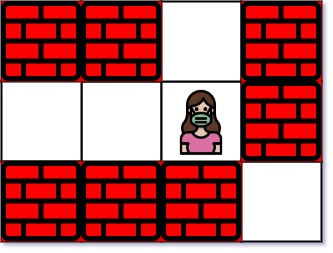
Input: maze = [["+","+",".","+"],[".",".",".","+"],["+","+","+","."]], entrance = [1,2]
Output: 1
Explanation: There are 3 exits in this maze at [1,0], [0,2], and [2,3].
Initially, you are at the entrance cell [1,2].
- You can reach [1,0] by moving 2 steps left.
- You can reach [0,2] by moving 1 step up.
It is impossible to reach [2,3] from the entrance.
Thus, the nearest exit is [0,2], which is 1 step away.
Example 2:

Input: maze = [["+","+","+"],[".",".","."],["+","+","+"]], entrance = [1,0]
Output: 2
Explanation: There is 1 exit in this maze at [1,2].
[1,0] does not count as an exit since it is the entrance cell.
Initially, you are at the entrance cell [1,0].
- You can reach [1,2] by moving 2 steps right.
Thus, the nearest exit is [1,2], which is 2 steps away.
Example 3:

Input: maze = [[".","+"]], entrance = [0,0]
Output: -1
Explanation: There are no exits in this maze.
2. Nearest Exit – Solution
The following is a solution which demonstrates how find the nearest exit from the entrance in a maze.
|
1 2 3 4 5 6 7 8 9 10 11 12 13 14 15 16 17 18 19 20 21 22 23 24 25 26 27 28 29 30 31 32 33 34 35 36 37 38 39 40 41 42 43 44 45 46 47 48 49 50 51 52 53 54 55 56 57 58 59 60 61 62 63 64 |
// ============================================================================ // Author: Kenneth Perkins // Date: Dec 1, 2022 // Taken From: http://programmingnotes.org/ // File: Solution.cs // Description: Demonstrates how to find nearest exit from entrance in maze // ============================================================================ public class Solution { public int NearestExit(char[][] maze, int[] entrance) { int rows = maze.Length; int cols = maze[0].Length; var directions = new List<KeyValuePair<int, int>>() { // Direction coordinates: (y, x) new KeyValuePair<int, int>(1, 0), new KeyValuePair<int, int>(-1, 0), new KeyValuePair<int, int>(0, 1), new KeyValuePair<int, int>(0, -1) }; char VISITED = '+'; char NOT_VISITED = '.'; // Mark the entrance as visited since its not a exit. int startRow = entrance[0]; int startCol = entrance[1]; maze[startRow][startCol] = VISITED; // Start BFS from the entrance, and use a queue `queue` to store all // the cells to be visited. var queue = new Queue<int[]>(); queue.Enqueue(new int[]{startRow, startCol, 0}); while (queue.Count > 0) { int[] currState = queue.Dequeue(); int currRow = currState[0]; int currCol = currState[1]; int currDistance = currState[2]; // For the current cell, check its four neighbor cells. foreach (var dir in directions) { int nextRow = currRow + dir.Key; int nextCol = currCol + dir.Value; // If there exists an unvisited empty neighbor: if (IsValidCell(maze, nextRow, nextCol) && maze[nextRow][nextCol] == NOT_VISITED) { // If this empty cell is an exit, return distance + 1. if (nextRow == 0 || nextRow == rows - 1 || nextCol == 0 || nextCol == cols - 1) { return currDistance + 1; } // Otherwise, add this cell to 'queue' and mark it as visited. maze[nextRow][nextCol] = VISITED; queue.Enqueue(new int[]{nextRow, nextCol, currDistance + 1}); } } } // If we finish iterating without finding an exit, return -1. return -1; } private bool IsValidCell(char[][] grid, int row, int col) { return row >= 0 && row < grid.Length && col >= 0 && col < grid[row].Length; } }// http://programmingnotes.org/ |
QUICK NOTES:
The highlighted lines are sections of interest to look out for.
The code is heavily commented, so no further insight is necessary. If you have any questions, feel free to leave a comment below.
Once compiled, you should get this as your output for the example cases:
1
2
-1
C# || How To Design A Time Based Key-Value Store To Retrieve Timestamps Using C#

The following is a module with functions which demonstrates how to design a time based key-value store to retrieve timestamps using C#.
1. Time Map – Problem Statement
Design a time-based key-value data structure that can store multiple values for the same key at different time stamps and retrieve the key’s value at a certain timestamp.
Implement the TimeMap class:
- TimeMap() Initializes the object of the data structure.
- void set(String key, String value, int timestamp) Stores the key key with the value value at the given time timestamp.
- String get(String key, int timestamp) Returns a value such that set was called previously, with timestamp_prev <= timestamp. If there are multiple such values, it returns the value associated with the largest timestamp_prev. If there are no values, it returns “”.
Example 1:
Input
["TimeMap", "set", "get", "get", "set", "get", "get"]
[[], ["foo", "bar", 1], ["foo", 1], ["foo", 3], ["foo", "bar2", 4], ["foo", 4], ["foo", 5]]
Output
[null, null, "bar", "bar", null, "bar2", "bar2"]Explanation
TimeMap timeMap = new TimeMap();
timeMap.set("foo", "bar", 1); // store the key "foo" and value "bar" along with timestamp = 1.
timeMap.get("foo", 1); // return "bar"
timeMap.get("foo", 3); // return "bar", since there is no value corresponding to foo at timestamp 3 and timestamp 2, then the only value is at timestamp 1 is "bar".
timeMap.set("foo", "bar2", 4); // store the key "foo" and value "bar2" along with timestamp = 4.
timeMap.get("foo", 4); // return "bar2"
timeMap.get("foo", 5); // return "bar2"
2. Time Map – Solution
The following is a solution which demonstrates how to design a time based key-value store to retrieve timestamps.
|
1 2 3 4 5 6 7 8 9 10 11 12 13 14 15 16 17 18 19 20 21 22 23 24 25 26 27 28 29 30 31 32 33 34 35 36 37 38 39 40 41 42 43 44 45 46 47 48 49 50 51 52 53 54 55 56 57 58 59 |
// ============================================================================ // Author: Kenneth Perkins // Date: Nov 1, 2022 // Taken From: http://programmingnotes.org/ // File: Solution.cs // Description: Demonstrates how to design a time map // ============================================================================ /** * Your TimeMap object will be instantiated and called as such: * TimeMap obj = new TimeMap(); * obj.Set(key,value,timestamp); * string param_2 = obj.Get(key,timestamp); */ public class TimeMap { private class Data { public string value; public int timestamp; public Data(string value, int timestamp) { this.value = value; this.timestamp = timestamp; } } private Dictionary<string, List<Data>> map; public TimeMap() { map = new Dictionary<string, List<Data>>(); } public void Set(string key, string value, int timestamp) { if (!map.ContainsKey(key)) { map.Add(key, new List<Data>()); } map[key].Add(new Data(value, timestamp)); } public string Get(string key, int timestamp) { if (!map.ContainsKey(key)) { return ""; } return BinarySearch(map[key], timestamp); } string BinarySearch(List<Data> bucket, int target) { int low = 0, high = bucket.Count; while (low < high) { int mid = low + (high - low) / 2; if (bucket[mid].timestamp <= target) { low = mid + 1; } else { high = mid; } } if (high == 0) { return ""; } return (bucket[high - 1].timestamp <= target) ? bucket[high - 1].value : ""; } }// http://programmingnotes.org/ |
QUICK NOTES:
The highlighted lines are sections of interest to look out for.
The code is heavily commented, so no further insight is necessary. If you have any questions, feel free to leave a comment below.
Once compiled, you should get this as your output for the example cases:
[null,null,"bar","bar",null,"bar2","bar2"]
C# || How To Return The Top K Frequent Words In Array Of Strings Using C#

The following is a module with functions which demonstrates how to get the top K frequent words in an array of strings using C#.
1. Top K Frequent – Problem Statement
Given an array of strings words and an integer k, return the k most frequent strings.
Return the answer sorted by the frequency from highest to lowest. Sort the words with the same frequency by their lexicographical order.
Example 1:
Input: words = ["i","love","leetcode","i","love","coding"], k = 2
Output: ["i","love"]
Explanation: "i" and "love" are the two most frequent words.
Note that "i" comes before "love" due to a lower alphabetical order.
Example 2:
Input: words = ["the","day","is","sunny","the","the","the","sunny","is","is"], k = 4
Output: ["the","is","sunny","day"]
Explanation: "the", "is", "sunny" and "day" are the four most frequent words, with the number of occurrence being 4, 3, 2 and 1 respectively.
2. Top K Frequent – Solution
The following are two solutions which demonstrates how to get the top K frequent words in an array of strings.
|
1 2 3 4 5 6 7 8 9 10 11 12 13 14 15 16 17 18 19 20 21 22 23 24 25 26 27 28 29 30 31 32 33 34 35 36 37 38 |
// ============================================================================ // Author: Kenneth Perkins // Date: Oct 23, 2022 // Taken From: http://programmingnotes.org/ // File: Solution.cs // Description: Determines how to get the top K frequent words in array // ============================================================================ public class Solution { public IList<string> TopKFrequent(string[] words, int k) { // Use a map to get the frequency of each word var frequency = new Dictionary<string, int>(); foreach (var word in words) { frequency[word] = frequency.GetValueOrDefault(word, 0) + 1; } // Get the frequency map as a list and sort var frequencyList = frequency.ToList(); frequencyList.Sort((a, b) => { // If words have the same frequency, sort // by their lexicographical order if (a.Value == b.Value) { return string.Compare(a.Key, b.Key); } // Sort by the frequency from highest to lowest return b.Value - a.Value; }); // Get the results var result = new List<string>(); for (int index = 0; index < frequencyList.Count; ++index) { result.Add(frequencyList[index].Key); if (result.Count == k) { break; } } return result; } }// http://programmingnotes.org/ |
QUICK NOTES:
The highlighted lines are sections of interest to look out for.
The code is heavily commented, so no further insight is necessary. If you have any questions, feel free to leave a comment below.
Once compiled, you should get this as your output for the example cases:
["i","love"]
["the","is","sunny","day"]












